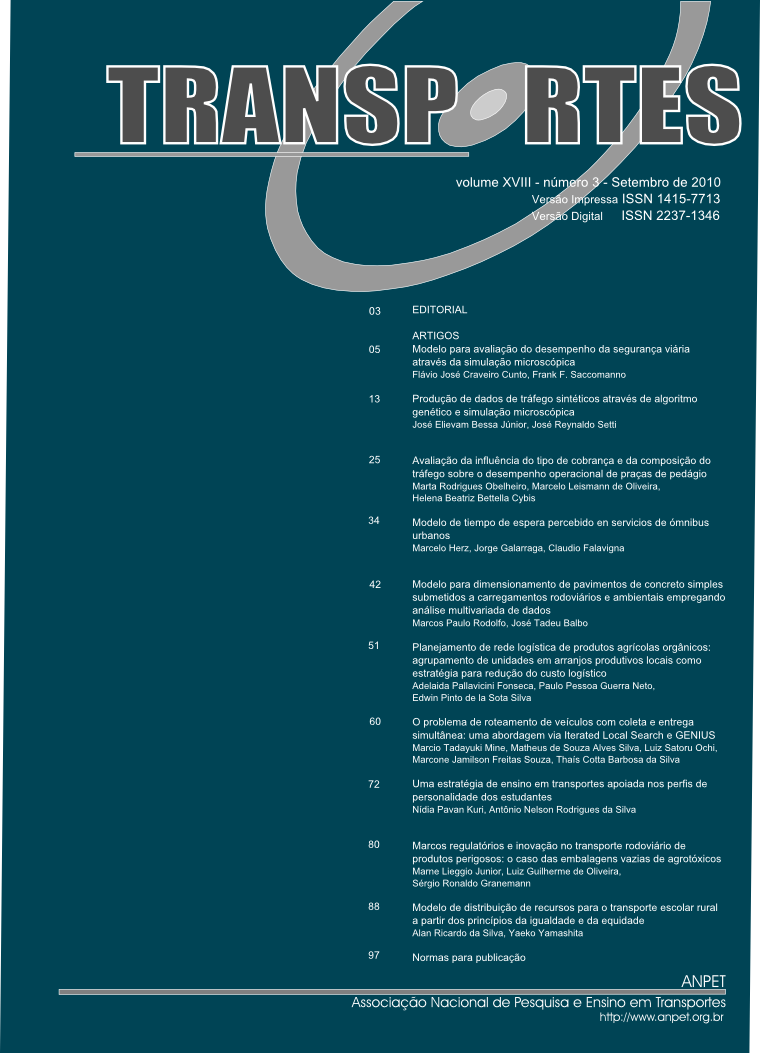Modelos para dimensionamento de pavimentos de concreto simples submetidos a carregamentos rodoviários e ambientais empregando análise multivariada de dados
DOI:
https://doi.org/10.14295/transportes.v18i3.450Abstract
Resumo: Diversos métodos modernos de dimensionamento de pavimentos em concreto de cimento Portland são desenvolvidos a partir da modelagem estatística das tensões que solicitam essas estruturas. Utilizando um projeto fatorial que abrange dimensões estruturais largamente adotadas em projetos brasileiros, os autores lançaram mão do método dos elementos finitos (MEF) para calcular as tensões decorrentes do efeito conjunto de um eixo padrão de 80 kN e de gradientes térmicos ambientais obtidos em pistas de teste brasileiras. Essas tensões foram trabalhadas sob a ótica da análise multivariada de dados, que é explicitada neste artigo. São propostos dois modelos de cálculo das tensões principais em placas de concreto, apoiadas em bases cimentadas ou bases granulares, que apresentaram resultados estatisticamente idênticos ao MEF original. Por fim é realizada uma aplicação dos modelos nacionais à estrutura de pavimento utilizada na nova pista da Rodovia dos Imigrantes em 2002 que havia sido dimensionada por critério não oficial estrangeiro.
Abstract: Several modern concrete pavement design guides are developed from the statistical modeling of the stresses found in those structures. Using a concrete pavement structures factorial project that considers widely adopted dimensions for slabs in Brazil, the authors applied the finite element method (FEM) to compute stresses caused by the joint effect of single axle loads of 80 kN and environmental thermal gradients obtained from Brazilian road tests. Those stresses were analyzed by the multivariate data analysis concepts formally presented herein. The authors present two models to compute principal stresses in concrete slabs, supported by unbounded cemented bases or by granular bases. The use of such equations results in statistically identical stresses to those computed by original FEM. At last, an application of such new models to the concrete pavement design of the former 2002 construction of Imigrantes Highway are presented and compared to the original design using a non official alien method.Downloads
Downloads
Published
How to Cite
Issue
Section
License
Authors who submit papers for publication by TRANSPORTES agree to the following terms:
- The authors retain the copyright and grant Transportes the right of first publication of the manuscript, without any financial charge, and waive any other remuneration for its publication by ANPET.
- Upon publication by Transportes, the manuscript is automatically licensed under the Creative Commons License CC BY 4.0 license. This license permits the work to be shared with proper attribution to the authors and its original publication in this journal.
- Authors are authorized to enter into additional separate contracts for the non-exclusive distribution of the version of the manuscript published in this journal (e.g., publishing in an institutional repository or as a book chapter), with recognition of the initial publication in this journal, provided that such a contract does not imply an endorsement of the content of the manuscript or the new medium by ANPET.
- Authors are permitted and encouraged to publish and distribute their work online (e.g., in institutional repositories or on their personal websites) after the editorial process is complete. As Transportes provides open access to all published issues, authors are encouraged to use links to the DOI of their article in these cases.
- Authors guarantee that they have obtained the necessary authorization from their employers for the transfer of rights under this agreement, if these employers hold any copyright over the manuscript. Additionally, authors assume all responsibility for any copyright infringements by these employers, releasing ANPET and Transportes from any responsibility in this regard.
- Authors assume full responsibility for the content of the manuscript, including the necessary and appropriate authorizations for the disclosure of collected data and obtained results, releasing ANPET and Transportes from any responsibility in this regard.









